Page 201 of 658
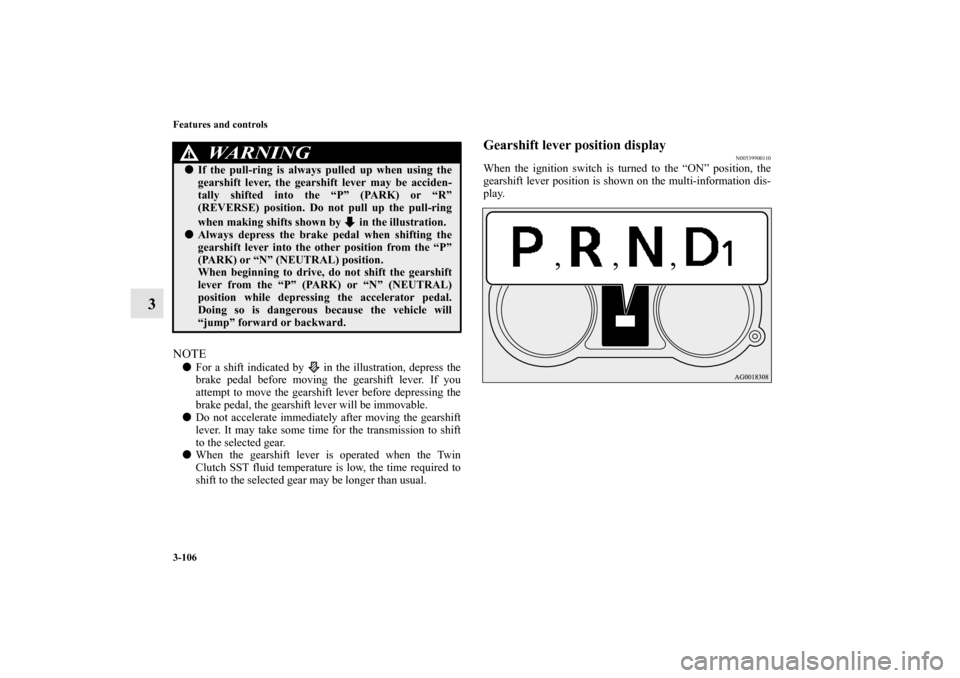
3-106 Features and controls
3
NOTE�
For a shift indicated by in the illustration, depress the
brake pedal before moving the gearshift lever. If you
attempt to move the gearshift lever before depressing the
brake pedal, the gearshift lever will be immovable.
�
Do not accelerate immediately after moving the gearshift
lever. It may take some time for the transmission to shift
to the selected gear.
�
When the gearshift lever is operated when the Twin
Clutch SST fluid temperature is low, the time required to
shift to the selected gear may be longer than usual.
Gearshift lever position display
N00539900110
When the ignition switch is turned to the “ON” position, the
gearshift lever position is shown on the multi-information dis-
play.
WA R N I N G
!�
If the pull-ring is always pulled up when using the
gearshift lever, the gearshift lever may be acciden-
tally shifted into the “P” (PARK) or “R”
(REVERSE) position. Do not pull up the pull-ring
when making shifts shown by in the illustration.
�
Always depress the brake pedal when shifting the
gearshift lever into the other position from the “P”
(PARK) or “N” (NEUTRAL) position.
When beginning to drive, do not shift the gearshift
lever from the “P” (PARK) or “N” (NEUTRAL)
position while depressing the accelerator pedal.
Doing so is dangerous because the vehicle will
“jump” forward or backward.
BK0103001US.book 106 ページ 2009年8月20日 木曜日 午前10時45分
Page 208 of 658
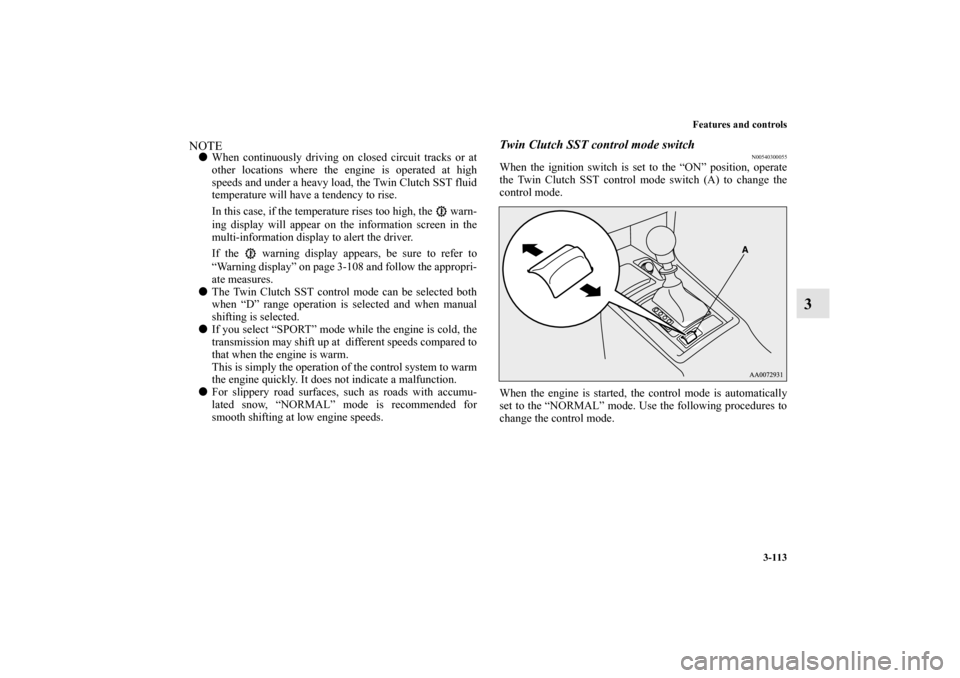
Features and controls
3-113
3
NOTE�
When continuously driving on closed circuit tracks or at
other locations where the engine is operated at high
speeds and under a heavy load, the Twin Clutch SST fluid
temperature will have a tendency to rise.
In this case, if the temperature rises too high, the warn-
ing display will appear on the information screen in the
multi-information display to alert the driver.
If the warning display appears, be sure to refer to
“Warning display” on page 3-108 and follow the appropri-
ate measures.
�
The Twin Clutch SST control mode can be selected both
when “D” range operation is selected and when manual
shifting is selected.
�
If you select “SPORT” mode while the engine is cold, the
transmission may shift up at different speeds compared to
that when the engine is warm.
This is simply the operation of the control system to warm
the engine quickly. It does not indicate a malfunction.
�
For slippery road surfaces, such as roads with accumu-
lated snow, “NORMAL” mode is recommended for
smooth shifting at low engine speeds.
Twin Clutch SST control mode switch
N00540300055
When the ignition switch is set to the “ON” position, operate
the Twin Clutch SST control mode switch (A) to change the
control mode.
When the engine is started, the control mode is automatically
set to the “NORMAL” mode. Use the following procedures to
change the control mode.
BK0103001US.book 113 ページ 2009年8月20日 木曜日 午前10時45分
Page 209 of 658
3-114 Features and controls
3
To shift from “NORMAL” mode to “SPORT” mode
While the vehicle is stopped or being driven, push the Twin
Clutch SST control mode switch forward.
To shift from “SPORT” mode to “NORMAL” mode
While the vehicle is stopped or being driven, push the Twin
Clutch SST control mode switch rearward.NOTE�
If the Twin Clutch SST control mode switch is continu-
ously pressed after a control mode has been selected, an
erroneous operation prevention function operates and the
control mode is automatically set to the “NORMAL”
mode.
If you would like to select a control mode again, return the
ignition switch to the “ACC” or “LOCK” position and
restart the engine. Then, push the Twin Clutch SST con-
trol mode switch.
Twin Clutch SST control mode display
N00540400072
When the ignition switch is set to the “ON” position, the cur-
rently selected control mode is displayed on the multi-informa-
tion display.
BK0103001US.book 114 ページ 2009年8月20日 木曜日 午前10時45分
Page 223 of 658
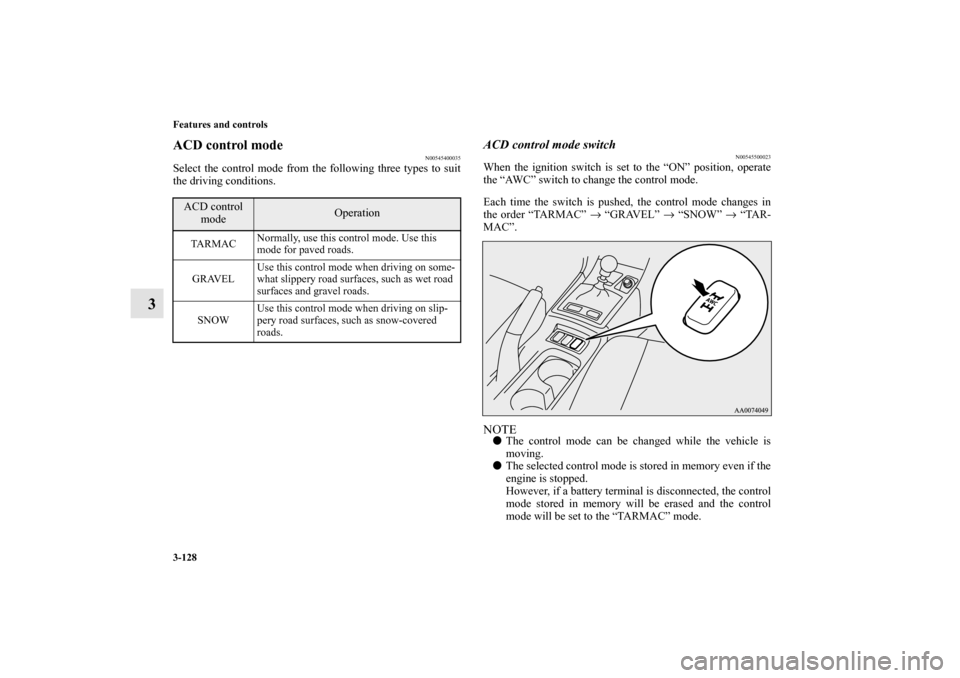
3-128 Features and controls
3
ACD control mode
N00545400035
Select the control mode from the following three types to suit
the driving conditions.
ACD control mode switch
N00545500023
When the ignition switch is set to the “ON” position, operate
the “AWC” switch to change the control mode.
Each time the switch is pushed, the control mode changes in
the order “TARMAC” → “GRAVEL” → “SNOW” → “TAR-
MAC”.NOTE�
The control mode can be changed while the vehicle is
moving.
�
The selected control mode is stored in memory even if the
engine is stopped.
However, if a battery terminal is disconnected, the control
mode stored in memory will be erased and the control
mode will be set to the “TARMAC” mode.
ACD control
mode
Operation
TA R M A CNormally, use this control mode. Use this
mode for paved roads.
GRAVELUse this control mode when driving on some-
what slippery road surfaces, such as wet road
surfaces and gravel roads.
SNOWUse this control mode when driving on slip-
pery road surfaces, such as snow-covered
roads.
BK0103001US.book 128 ページ 2009年8月20日 木曜日 午前10時45分
Page 227 of 658
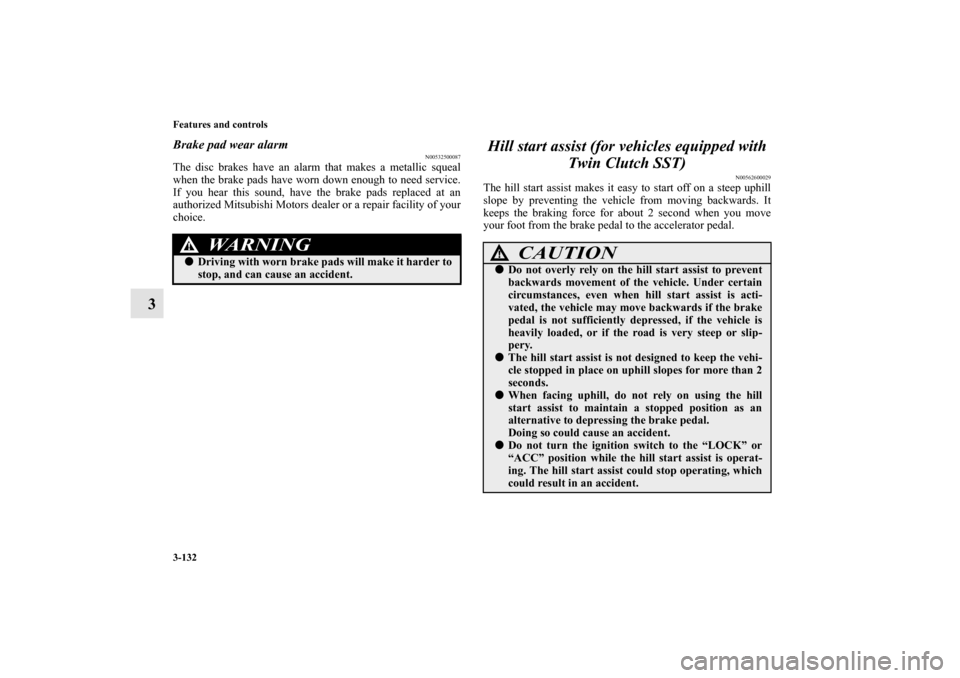
3-132 Features and controls
3
Brake pad wear alarm
N00532500087
The disc brakes have an alarm that makes a metallic squeal
when the brake pads have worn down enough to need service.
If you hear this sound, have the brake pads replaced at an
authorized Mitsubishi Motors dealer or a repair facility of your
choice.
Hill start assist (for vehicles equipped with
Twin Clutch SST)
N00562600029
The hill start assist makes it easy to start off on a steep uphill
slope by preventing the vehicle from moving backwards. It
keeps the braking force for about 2 second when you move
your foot from the brake pedal to the accelerator pedal.
WA R N I N G
!�
Driving with worn brake pads will make it harder to
stop, and can cause an accident.
CAUTION
!�
Do not overly rely on the hill start assist to prevent
backwards movement of the vehicle. Under certain
circumstances, even when hill start assist is acti-
vated, the vehicle may move backwards if the brake
pedal is not sufficiently depressed, if the vehicle is
heavily loaded, or if the road is very steep or slip-
pery.
�
The hill start assist is not designed to keep the vehi-
cle stopped in place on uphill slopes for more than 2
seconds.
�
When facing uphill, do not rely on using the hill
start assist to maintain a stopped position as an
alternative to depressing the brake pedal.
Doing so could cause an accident.
�
Do not turn the ignition switch to the “LOCK” or
“ACC” position while the hill start assist is operat-
ing. The hill start assist could stop operating, which
could result in an accident.
BK0103001US.book 132 ページ 2009年8月20日 木曜日 午前10時45分
Page 231 of 658
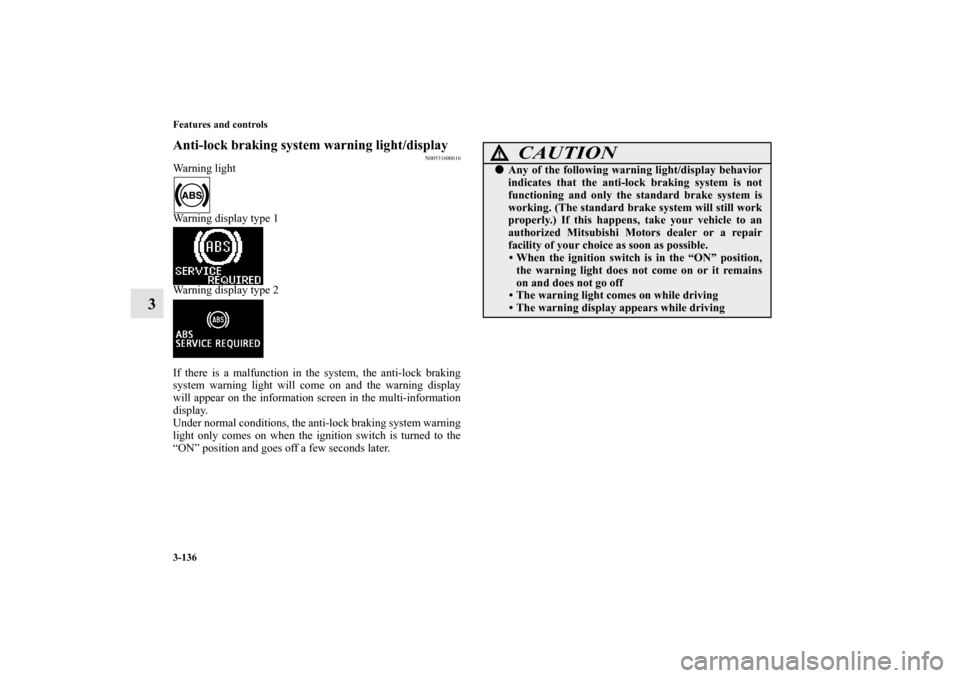
3-136 Features and controls
3
Anti-lock braking system warning light/display
N00531600616
Warning light
Warning display type 1
Warning display type 2
If there is a malfunction in the system, the anti-lock braking
system warning light will come on and the warning display
will appear on the information screen in the multi-information
display.
Under normal conditions, the anti-lock braking system warning
light only comes on when the ignition switch is turned to the
“ON” position and goes off a few seconds later.
CAUTION
!�
Any of the following warning light/display behavior
indicates that the anti-lock braking system is not
functioning and only the standard brake system is
working. (The standard brake system will still work
properly.) If this happens, take your vehicle to an
authorized Mitsubishi Motors dealer or a repair
facility of your choice as soon as possible. When the ignition switch is in the “ON” position,
the warning light does not come on or it remains
on and does not go off
The warning light comes on while driving
The warning display appears while driving
BK0103001US.book 136 ページ 2009年8月20日 木曜日 午前10時45分
Page 235 of 658
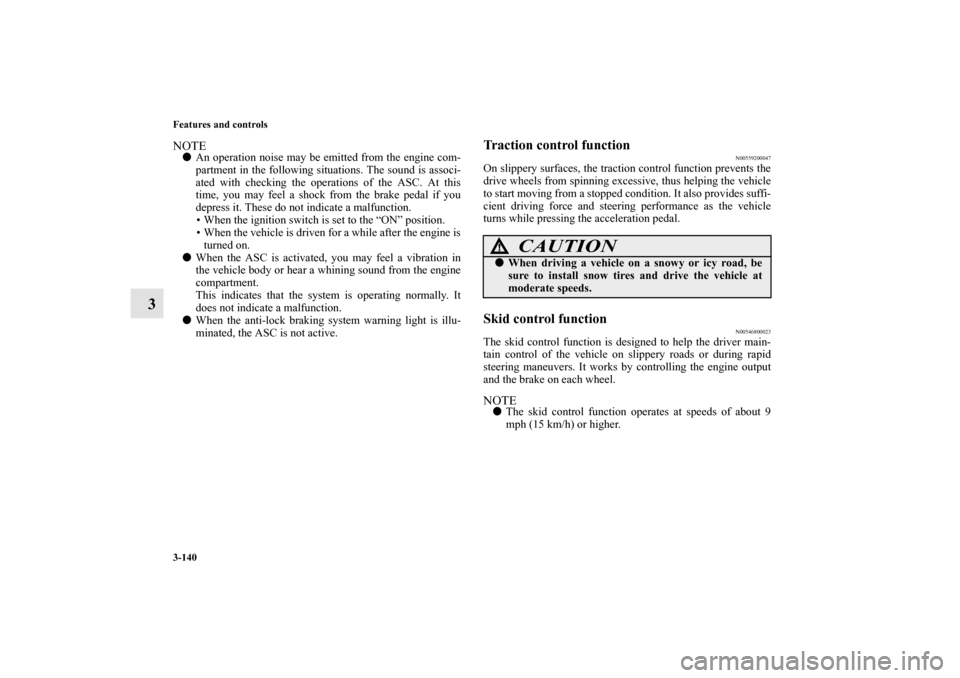
3-140 Features and controls
3
NOTE�
An operation noise may be emitted from the engine com-
partment in the following situations. The sound is associ-
ated with checking the operations of the ASC. At this
time, you may feel a shock from the brake pedal if you
depress it. These do not indicate a malfunction.
When the ignition switch is set to the “ON” position.
When the vehicle is driven for a while after the engine is
turned on.
�
When the ASC is activated, you may feel a vibration in
the vehicle body or hear a whining sound from the engine
compartment.
This indicates that the system is operating normally. It
does not indicate a malfunction.
�
When the anti-lock braking system warning light is illu-
minated, the ASC is not active.
Traction control function
N00559200047
On slippery surfaces, the traction control function prevents the
drive wheels from spinning excessive, thus helping the vehicle
to start moving from a stopped condition. It also provides suffi-
cient driving force and steering performance as the vehicle
turns while pressing the acceleration pedal.Skid control function
N00546800023
The skid control function is designed to help the driver main-
tain control of the vehicle on slippery roads or during rapid
steering maneuvers. It works by controlling the engine output
and the brake on each wheel.NOTE�
The skid control function operates at speeds of about 9
mph (15 km/h) or higher.
CAUTION
!�
When driving a vehicle on a snowy or icy road, be
sure to install snow tires and drive the vehicle at
moderate speeds.
BK0103001US.book 140 ページ 2009年8月20日 木曜日 午前10時45分
Page 236 of 658
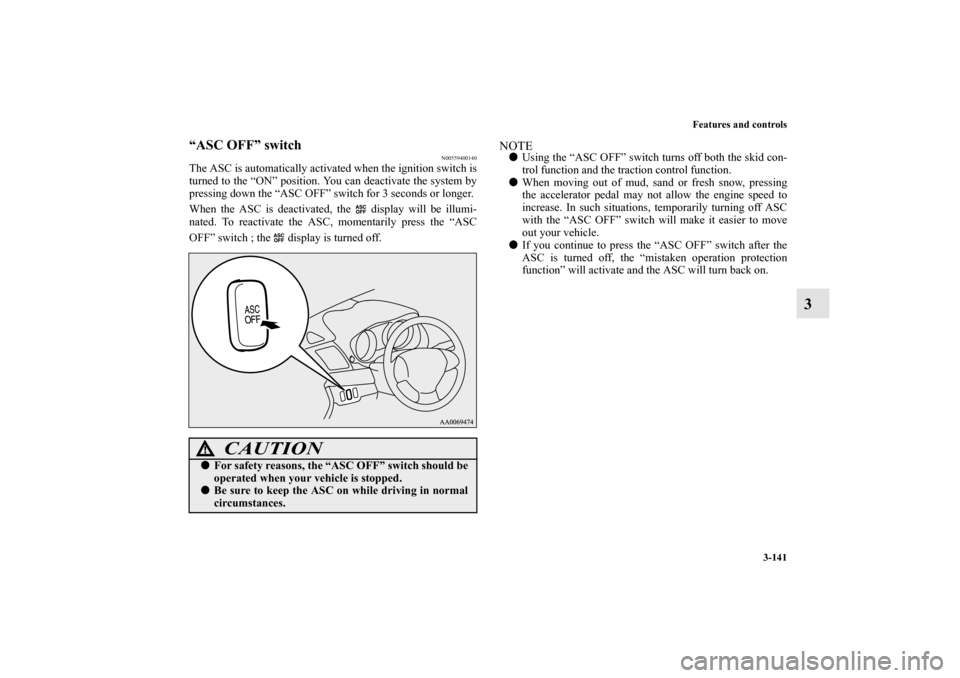
Features and controls
3-141
3
“ASC OFF” switch
N00559400140
The ASC is automatically activated when the ignition switch is
turned to the “ON” position. You can deactivate the system by
pressing down the “ASC OFF” switch for 3 seconds or longer.
When the ASC is deactivated, the display will be illumi-
nated. To reactivate the ASC, momentarily press the “ASC
OFF” switch ; the display is turned off.
NOTE�
Using the “ASC OFF” switch turns off both the skid con-
trol function and the traction control function.
�
When moving out of mud, sand or fresh snow, pressing
the accelerator pedal may not allow the engine speed to
increase. In such situations, temporarily turning off ASC
with the “ASC OFF” switch will make it easier to move
out your vehicle.
�
If you continue to press the “ASC OFF” switch after the
ASC is turned off, the “mistaken operation protection
function” will activate and the ASC will turn back on.
CAUTION
!�
For safety reasons, the “ASC OFF” switch should be
operated when your vehicle is stopped.
�
Be sure to keep the ASC on while driving in normal
circumstances.
BK0103001US.book 141 ページ 2009年8月20日 木曜日 午前10時45分